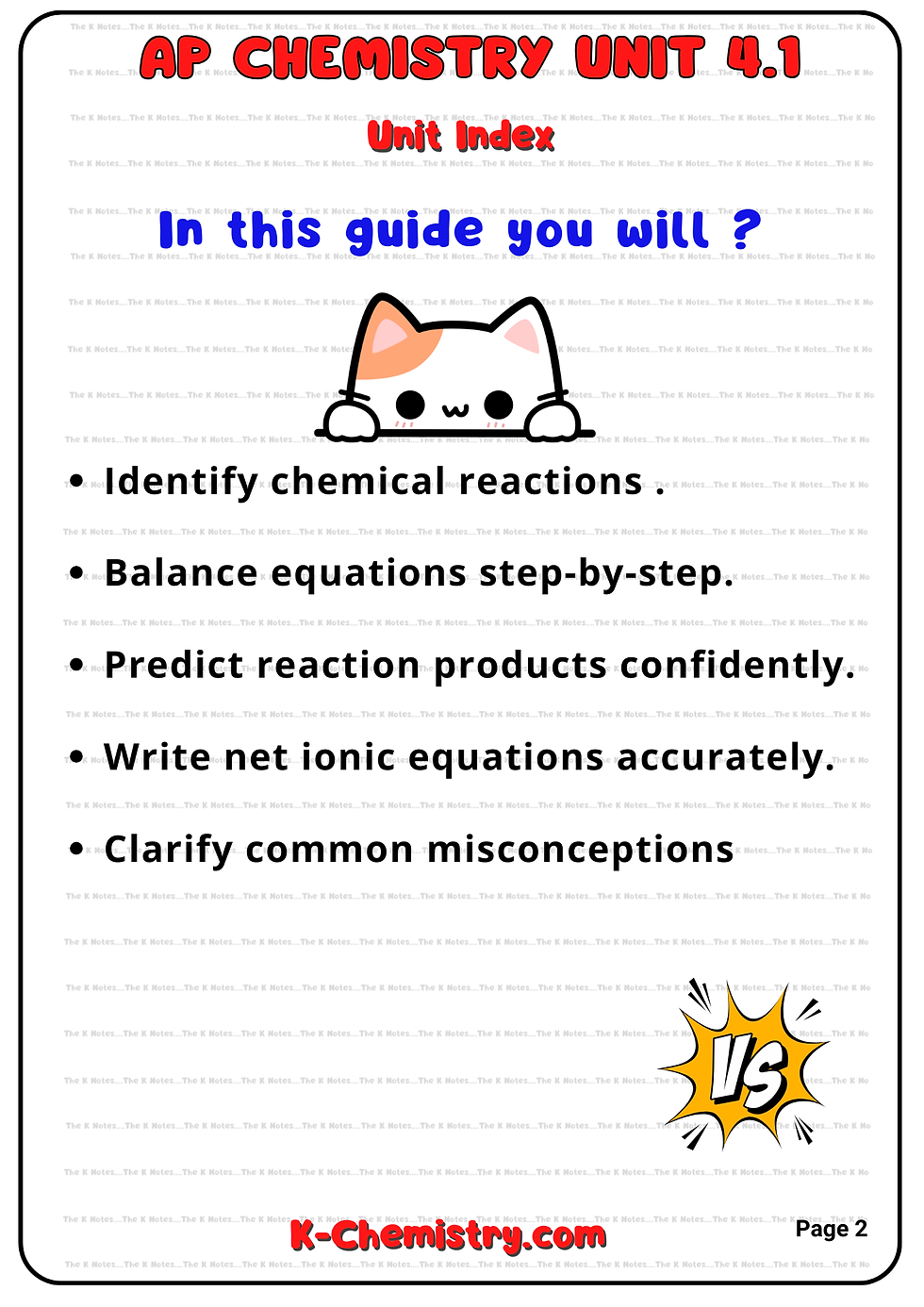Step By Step AP CHEMISTRY Study Guides
Study Guide Unit 1
Study Guide Unit 2
Study Guide Unit 3
Study Guide Unit 5
Study Guide Unit 6
Study Guide Unit 8
Study Guide Unit 9
Step By Step Study Guides And Questions to help you ace your study
Cheat Sheets
Cheat Sheet Unit 1
Cheat Sheet Unit 2
Cheat Sheets
Cheat Sheets
Cheat Sheets
Cheat Sheets
Cheat Sheets
Cheat Sheets
AP CHEMISTRY
Best Selling Docs
Browse By Unit :
Unit 1 AP Chemistry
Unit 2 AP Chemistry
Explore the Collection
Go through Our Different AP Chemistry Study Helpers.
AP CHEMISTRY
AP CHEMISTRY

1. What topics are covered in the AP Chemistry exam? The AP Chemistry exam covers a wide range of topics split into nine units. These include atomic structure and properties, molecular and ionic bonding, intermolecular forces, chemical reactions, kinetics, thermodynamics, equilibrium, acids and bases, and electrochemistry. Each topic is designed to reflect college-level introductory chemistry and includes both conceptual and quantitative components. Topics like equilibrium, stoichiometry, and bonding are often emphasized as they recur frequently in both the multiple-choice and free-response sections.
2. How is the AP Chemistry exam structured? The exam has two main sections: multiple-choice and free-response. The multiple-choice section consists of 60 questions with a total duration of 90 minutes. These questions test a mix of theoretical understanding and problem-solving skills. The free-response section has seven questions (three long and four short answers) to be completed in 105 minutes. This section emphasizes lab-based scenarios, calculations, and conceptual analysis. Both sections are weighted equally at 50% of the total score.
3. What is the format of the multiple-choice section? The multiple-choice section includes 60 questions and is completed without a calculator. Questions focus on analyzing graphs, understanding chemical trends, applying formulas, and solving quantitative problems. These questions are not grouped by topic, so students need to be prepared to switch between concepts like kinetics and bonding quickly. Some questions may present experimental data, requiring students to infer conclusions or trends.
4. What types of questions are in the free-response section? The free-response section has three long-answer questions and four short-answer questions. Long-answer questions often involve multi-step calculations, data interpretation, and experimental design. Short-answer questions may focus on specific concepts such as Lewis structures, reaction mechanisms, or thermodynamic calculations. The section aims to test students’ ability to analyze and solve real-world chemistry problems in depth.
5. How much time is allotted for each section of the exam? Students are given 90 minutes to complete the multiple-choice section and 105 minutes for the free-response section. Time management is critical, especially in the free-response section where multi-step problems can take longer. It’s recommended to spend about 20 minutes on each long-answer question and around 10-15 minutes on each short-answer question.
6. What materials are provided during the exam (e.g., periodic table, formula sheet)? The College Board provides a periodic table with element symbols, atomic masses, and key constants. Additionally, a formula sheet containing common equations (e.g., ideal gas law, rate laws, and thermodynamic equations) and constants is provided. Students should familiarize themselves with these resources before the exam to save time during the test.
7. Are calculators allowed during the exam? calculators are now allowed in both the multiple-choice and free-response sections of the AP Chemistry Exam. This policy change means students can use calculators throughout the exam. The updated policy also specifies: Students may use scientific or graphing calculators that meet the requirements. For digital AP exams, a built-in Desmos scientific calculator will be available. If you would like more detailed information, you can review the official College Board policy on their website: AP Calculator Policies.
8. What are the key concepts to focus on for the exam? Key concepts include stoichiometry, periodic trends, thermodynamics, equilibrium, kinetics, and acid-base chemistry. Understanding these areas is critical, as they often form the foundation of exam questions. Additionally, mastering lab techniques and data analysis is essential for the free-response section, as experimental setups are frequently included.
9. How can I effectively prepare for the AP Chemistry exam? Effective preparation involves reviewing high-yield topics, practicing with past exams, and utilizing study guides. Resources like College Board practice exams and online platforms can provide exposure to exam-style questions. Spaced repetition and consistent review help reinforce key concepts. Joining study groups or seeking help from teachers can also clarify challenging topics.
10. What are common mistakes to avoid on the exam? Common mistakes include rushing through questions, neglecting significant figures, and misunderstanding the question stem. In free-response, many students lose points by not showing their work or skipping steps in calculations. Careful reading, double-checking units, and providing complete explanations are essential for avoiding these errors.
























